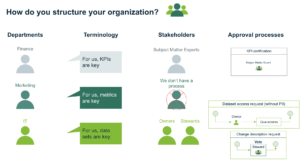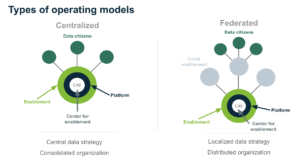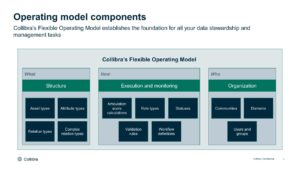Data governance is the essential foundation for organizations looking to create business value from data. It creates the structure that enables collaboration on and analysis of trusted data. Setting up effective data governance, however, can be quite challenging. Data governance practices require supporting technology, and that technology must include a flexible operating model that allows organizations to design governance programs in a way that works for their unique needs.
What is an operating model in data governance?
An operating model outlines how an organization defines roles, responsibilities, business terms, asset types, relations, domain types, and more. This, in turn, affects how workflows and processes function; it impacts how an organization operates around its data.
The operating model is the basis for any data governance program. By defining enterprise roles and responsibilities across the different lines of business, the operating model helps establish an enterprise governance structure.
Operating model example
Consider this scenario: your organization is creating a workflow for defining KPIs in your business glossary as part of your data governance program. These workflows will allow teams to collaborate and communicate more effectively. Multiple teams use data and KPIs, so you’ll want to create one standard approval workflow for all teams, right? Not quite.
Do all of these teams use KPIs in the same way? Do they all refer to KPIs as KPIs? What if the finance team uses the term “KPIs,” but the marketing team uses the term “metrics” and the IT team uses “data sets?” How will that affect the workflows?
How is your organization structured? What are the different business units? What is the approval process? Are the stakeholders different across business units?
The answers to these questions will all affect how you set up your workflows.

Every organization is structured differently, with its own set of processes and its own ways of communicating. Even within each organization, processes and terminologies may differ across departments and teams.
What are the types of operating models in data governance?
There is no one size fits all operating model in data governance; an organization must adopt an operating model specific to its needs. The operating model must balance two polar principles, centralization and federation. An organization may adopt one of these two types or even embrace both principles. An organization can adopt one of two types of operating models, centralized or federated, depending on its needs.
- Centralized operating model: A central authority determines the rules of how to govern data in the organization. This central authority defines standard processes for implementation of data governance principles, such as how to define critical data elements and how to approve business terms. When individuals and teams execute data governance tasks, they must adhere to the centrally defined processes.
- Federated operating model: This is when there are multiple groups of authority. An organization may adopt this model if different teams have different data governance needs.

There are advantages and disadvantages to both types. Centralized operating models are simpler and easier to maintain, but they can make some teams feel restricted by the central data governance authority. Federated operating models allow different teams to adopt data governance at different paces, but sometimes it may become more complex or difficult to maintain. As a result, organizations often adopt a hybrid model customized to its needs which balances the advantages of centralization and federation.
What are the components of an operating model?
An operating model in data governance can be divided into three subdivisions that answer what, how, and who governs data. Within all of these subdivisions are various components. Some components may be more integral than others depending on the organization’s priorities, frameworks, process orientation and more. There is no need to address every component of an operating model at once; you should take a step-by-step approach based on your priorities, frameworks and process orientation. Nonetheless, it can be helpful to understand the different aspects as you identify what you need right now and what you may need in the future.

What needs to be governed?
The first component of an operating model is the what, which addresses the structural concepts. This component delineates the various pieces of information that need to be governed. You can categorize the structural concepts into four types:
- Asset types – An asset type defines the semantics of an asset. For example, “personal privacy policy” is the name of an asset of type “policy” and “customer” is the name of an asset of type “business term.”
- Attribute types – An attribute is a literal value that captures information about an asset.
- Relation types – A relation defines how two assets are related to each other. A relation type formally defines the type of a relation between two Asset Types.
- Complex relation types – A complex relation type defines the relations between three or more assets or attributes.
How should this information be governed?
The second component of an operating model is the how, which covers the execution and monitoring concepts.
- Articulation score calculations – The articulation score of an asset is a percentage that indicates how complete the asset is according to the articulation score rules.
- Role types – Roles provide users permissions on a given resource (asset, domain, community) or software modules in general. Role types are a group of permissions that can be assigned to a user or group.
- Statuses – A status indicates the phase in the life cycle that an asset is in
- Validation rules – A validation rule defines a script that allows to check if the content of a particular asset is valid.
- Workflow definitions – A workflow definition describes how a process can be automated. It identifies the steps, assigns tasks to the right user/role and executes some automated logic.
-
Who governs it?
The third component of an operating model is the who, which signifies the organizational concepts. Use stewardship to bring all teammates together while maintaining defined roles and responsibilities for data management.
- Communities – A community is a grouping of zero or more communities and Domains and usually defines a delineated part of stewardship.
- Domain – A domain is a logical grouping of assets according to their function, project, or knowledge area.
- Users and groups – Organizations can define users or groups of users to ease granting roles and permissions.
What is a flexible operating model in data governance?
Different departments, teams, and roles all behave differently within an organization and have unique needs. A flexible operating model ensures that everyone can design a model that works for them while still integrating into the broader effort of the organization to achieve true and lasting Data Intelligence. Organizations need a flexible operating model to define roles, responsibilities, and terms according to their needs.
What are the benefits of a flexible operating model?
The primary benefit of a flexible operating model is that it allows you to build a data governance framework specifically tailored to your organization’s needs. It allows you to:
- Extend and coordinate – A federated flexible operating model allows teams to enhance the model to meet their unique needs.
- Create a shared language – Build a common understanding around data to facilitate collaboration.
- Build for all users – Balance the needs of technical and business users with a collaborative operating model.
- Sustain high performance – Scale and adapt models as the business environment changes and asset and relation types evolve.
An operating model serves as the backbone to data governance, and consequently, digital transformation and Data Intelligence. Leverage a flexible operating model so you can get your data governance program up and running fast and adapt to any use case.
Where to start with a flexible operating model
All organizations need data governance to become data-driven and, therefore, need an operating model. The benefits of a flexible operating model are outstanding, but the long list of components seems complex and daunting. So where does an organization start with an operating model? The answer is, wherever it is right for that organization’s priorities at the time. Factors such as the organization’s maturity, structure, and use cases will impact where to start. A flexible operating model allows an organization to get started according to its priorities rather than follow the rigid requirements of its technology solution.
Consider this: a healthcare company and a retailer both need data governance, but they may have different priorities for data governance use cases.
A healthcare organization may need to ramp up its data governance in order to meet standards for Health Insurance Portability and Accountability Act (HIPAA). Since its use case is about privacy and regulatory compliance, its first priorities in the operating model may be around defining asset types to classify data based on sensitivity and then building workflows to ensure processes are followed and completed.
On the other hand, the retailer’s first use case may be supply chain analytics, so it can deliver products to its customers as swiftly as possible. Its priority in the operating model may be to set up workflows to speed up processes and eliminate operational inefficiencies.
Both organizations need data governance and need an operating model to get started, but a flexible operating model allows them to start where it makes sense for them.
Collibra offers a Flexible Operating Model so that our customers can define roles, responsibilities, and terms according to their needs. Collibra meets the customers where they are, rather than the other way around. Collibra partners with our customers, guiding them where to start with the operating model and working with them along the way as their programs mature. Our operating model is not only flexible, but also extendible; we offer out-of-the-box templates and prescriptive paths to accelerate time to value. We partner with our customers on every step, so they can achieve lasting Data Intelligence.




